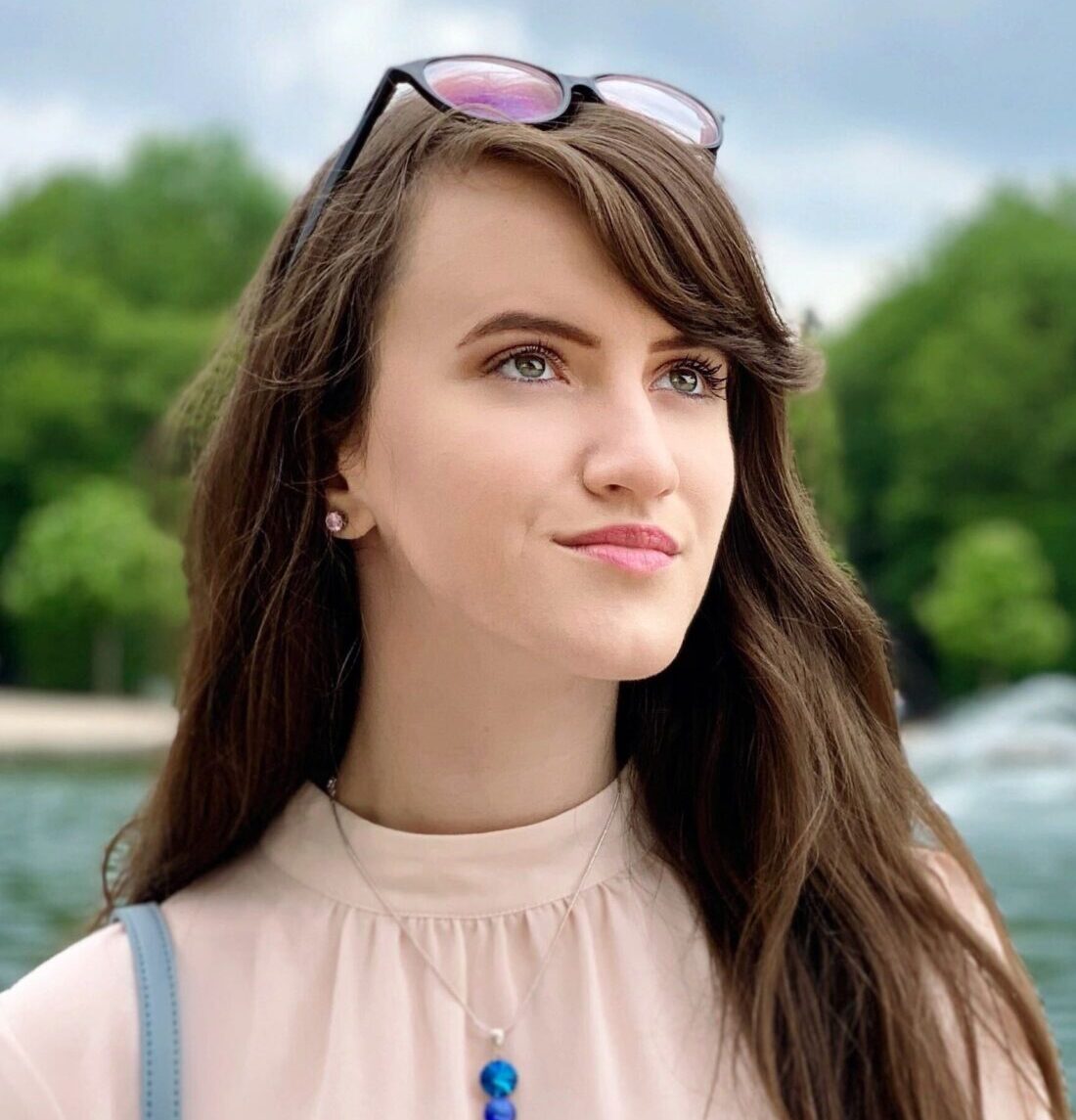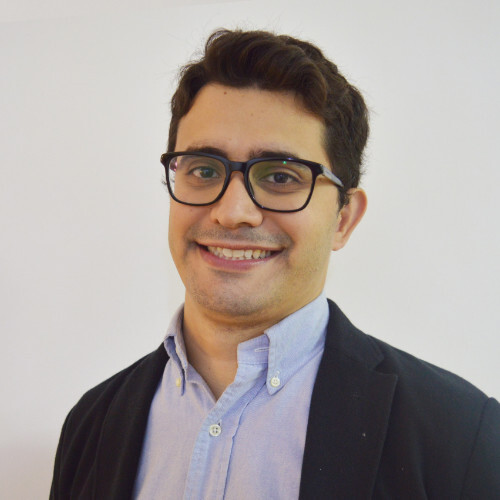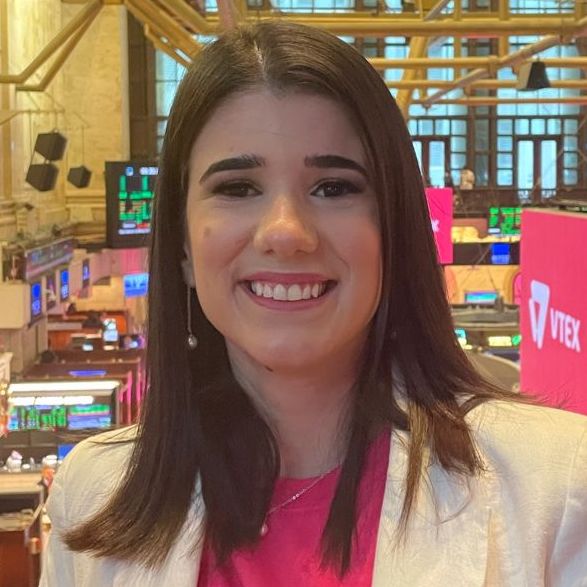
Innovation and simplicity in design are some of the main elements that make products interesting for both the customer and the development team. Reaching those elements requires objectives and routines that allow creative thinkers to explore their full potential in a productive and stimulating way, being part of dynamic teams that are focused on a collective goal of excellence.
As a Software as a Service company, building products that meet our customers needs is at the core of our daily tasks. At VTEX, Product Managers, Designers and Engineers collaborate to build our product vision and deliver the best possible experience.
In the second episode of Beyond Predictable, we invited Ashley Denisov and Gabriel Carvalho, to a conversation about prototyping, designing, and building a future with unique products in the Digital Commerce market.
- Ashley is Senior Product Manager. She has a Degree in Design & Media Arts from the University of California, Los Angeles, and has previously worked as a UX Designer for companies such as Sony and BigCommerce, before joining our team;
- Gabriel is currently Lead Product Designer at VTEX. He has a degree in Graphic Design and specialization in Design Thinking and Contemporary Design. He joined VTEX as a Product Designer and today leads a team of about 30 Designers, contributing to the development of new products and allowing the creation of simple and innovative solutions that meet our global market’s needs.
You can listen to this extraordinary conversation below:
These are the main insights from our conversation:
- Foregoing an expected scenario to make your vision come true can lead to making it reality where you already are. Communicating objectives clearly to your peers and to yourself is the key to finding ways to bring those goals to the present, promoting change around you instead of waiting for the chance to find it elsewhere.
- Milestones are reached by keeping a clear view of both short and long-term goals. Problems of the hour and the push towards a declared future require a careful balance of resources and attention, so it’s important to keep short-term objectives as useful steps that are directly linked to the achievement of larger goals.
- The declared future emerges from a clear vision of it in the present. Successful projects begin in the future, with collective envisioning of the best product to be developed. By establishing the final result from the prototyping phase, challenges found along the way are solved by reaching for that declared standard.
- Shared work is also shared growth. Expansion of one area of the company leads to the growth of all teams, so keeping a cohesive vision of the future and a high-performance mindset across all talent is the guarantee of a successful march onto the next big thing.
- Likewise, shared growth is shared work. Be aware of other people’s needs and challenges across teams and functions, so your personal effort doesn’t lose focus from the destination where the whole group is going.
If you prefer, you can also read the complete transcription of the conversation below.
Do you want to know more about how VTEXers are building an extraordinary future? Stay tuned for our next episodes!
[Ashley Denisov] Hi, Gabriel! How are you today?
[Gabriel Carvalho] Hi, Ashley. Thank you very much for this awesome introduction! I’m doing just fine. How are you?
[Ashley Denisov] Can you tell us a bit about your background? How did you join VTEX?
[Gabriel Carvalho] Sure! I’m a product designer here at VTEX. When I first joined VTEX, I was hoping to stay here just for a little while. I was a graphic designer, and I was hoping to migrate to Product cause I had this crazy obsession with working for a Big Tech company in Europe or the United States. My dream was to work on Spotify or Netflix, something like that. So, I was hoping I could create something fast here at VTEX, build a strong portfolio, and apply for a job abroad.
Five years went by, and I’m still here. The thing is, I was the third designer in VTEX when I joined. The company grew a lot, and I had to work really hard to keep up with the design work and also hire and mentor other designers. As I was doing that, some people started noticing me and started inviting me to some strategic conversations about the company’s future. I remember one day, when I was having dinner with Anderson and Guilherme, two former engineers who are now leading culture and hiring, they asked me why I was so obsessed with working at a Big Tech company. I answered, “Well, I want to work with a big design team in a place with a strong product culture, building a product that I’m proud of, that is elegant and easy to use.” Just as I finished saying that, they said that that was exactly what they wanted for VTEX. They wanted my help to build a design team, to implement a solid product culture, and to create a product that our customers would love. Instead of “working at Spotify,” I could “create a company just like Spotify from scratch.” And I could do that in my hometown, in my own country. I totally loved that idea.
So, I gave up the idea of working for a company abroad, and I’ve been here ever since—building this product, this team, and this culture. We were three designers back then, and we are now more than thirty. We’re improving and transforming our product and our customer’s lives every day alongside our beloved product managers! Speaking of which, what about you, Ashley?
[Gabriel Carvalho] Could you also introduce yourself and tell us a bit about your background and how you joined VTEX?
[Ashley Denisov] Sure! So, I’m a Product Manager here at VTEX. Before I started here, I worked as a UX designer at BigCommerce. At that time, as a personal hobby, I was also studying fashion and pattern making. I had been designing and sewing clothing since I was a student at UCLA, and it was at that point I wanted to build a company and launch a small clothing line.
Having had the insights of our SMB customers and how they built their businesses, I felt I had the blueprint for starting an online store of my own. I continued to freelance with BigCommerce as I built this, balancing a perspective of both being one of our customers and creating a SaaS product designed for my own needs.
Although funny enough, I did not choose BigCommerce to build my online store, but Shopify. To specify, this was in 2015, and at the time, I felt Shopify had more intuitive support for solo entrepreneurs just starting out. Still, it was one more experience that broadened my perspective on what was available to small business owners like myself.
So, half of my time was spent behind a desk designing, and the other half, I was at warehouses in LA, establishing relationships with manufacturers and building my supply chain. It was at this time I began to understand several unique challenges, at least from the perspective of the fashion industry, that could be opportunities for growth. For example, most of my business was selling my product directly to consumers, but I had no easy way to manage my inventory and pricing for prospective wholesale buyers. The B2C and B2B aspects of my company were equally important to its profitability, yet only half of the company’s business needs could be managed this way, the part intrinsically connected to an online store. This feels like a key entry barrier between small business owners and the more robust SaaS solutions of today. Most small businesses just starting out cannot afford custom SaaS solutions that could better address a more complicated supply chain, yet almost every fashion business has some B2B/B2C crossover and the need to manage different types of inventory in more complex ways.
This is an area where I see VTEX taking great strides to address customer satisfaction now, creating a multichannel solution that assumes any potential need across B2C, B2B, marketplace, and physical stores.
[Gabriel Carvalho] That’s fantastic, Ashley! It is amazing to have a product manager working on our e-commerce platform that has previously run her own online store! That, for sure, makes it a lot easier to create a product since you were a user a few months ago. And now that you are building a product that is intended for retailers just as you were, how do you do that? What is the process of building a product here at VTEX like?
[Ashley Denisov] Here at VTEX, our product vision is intrinsically linked to our declared company future. Right now, we have declared milestones we want to achieve for our company’s future in 2024. Having this clear vision, we create 2021 milestones that we clearly link to these goals, and then we break these milestones down into achievable ones for each quarter to keep ourselves accountable for achieving our big goals.
This, in my opinion, provides our product with two perspectives: it keeps our big-company goals a reality that we are achieving in our day-to-day. Then, when we break these big goals down, we keep our achievements hyper customer-focused and make sure we include our scope fixes and improvements as well as new features needed by our customers.
We make a point to repeat this often and transparently, in company-wide formats, such as our Demo Friday ritual, which is our weekly all-hands meeting. We share product updates weekly and, monthly, an overview of our progress is presented in tandem with live demos of product updates.
[Gabriel Carvalho] How do you think this helps us build a better experience for our customers?
[Ashley Denisov] We have big goals for VTEX’s future, but sometimes it can be easy to get caught up in broken windows, bug fixing, and answering our customers’ immediate concerns along the way. All of these things are important, but we have to be realistic about our resources and what we can achieve quarterly. So, having rituals built into our quarterly milestones that require us to remember what we’re working towards in 2024 is a great way to keep us on the road towards our desired future, in a realistic way, while taking into account all of the improvements and customer feedback we need to answer now. We want to be the VTEX our customers need today while building towards what will expand their abilities beyond the predictable tomorrow.
[Gabriel Carvalho] Can you give us some examples?
[Ashley Denisov] Right now, one of my favorite new traditions we have created is our 2021 champagne milestones. It started when each product squad was presenting their 2021 roadmap to our CEO, Geraldo. When he saw a milestone presented by a team that he was really excited about for the upcoming year, he would say, “If we pull that off, I’ll pop a bottle of champagne!”
So we thought this is a fun way to refer to the milestones that may have felt like stretch goals before but are now listed on our declarations and that we’re the most excited to achieve.
[Gabriel Carvalho] Totally! I can’t wait for this pandemic to be over so we can celebrate popping real champagnes in our offices! Or at least having a nice cake!
[Ashley Denisov] Yes, and I can’t wait to finally travel to the VTEX offices in Brazil and meet everyone in person! And what about you, Gabriel? Can you share with us a little bit about the process of designing our solutions?
[Gabriel Carvalho] Sure! So, as you know, we work pretty closely with the product managers and software engineers to build our products, same as every other technology company, but here at VTEX, the product designers play a fundamental role regarding the vision of the product.
The thing is, here at VTEX, we always start from the future. We have this declared future that you mentioned which drives every action that we take. But it’s really hard to be aligned with a future that is pretty hard to see. There’s no picture of the 2024 milestones. We haven’t built a time machine yet that enables us to travel to the future and see how it looks. And that’s where the designers come in. Here at VTEX, the designers are responsible for bringing this future closer, and we do that by prototyping the solution. Months before it goes live, we are sketching and prototyping ideas of how our future looks like. And these prototypes are essential to achieve team alignment. Without them, we have no vision of where our efforts should aim.
So, the thing is, instead of understanding what the technical limitations of our product are today or maybe analyzing the capacity of the engineering team, way before the MVP, we prototype the vision. What is the best possible solution that we can create for a specific problem in a perfect world? We prototype that. Once the whole team and stakeholders are aligned with that vision, we start thinking about the MVP, the first thing we can launch; what are the limitations we have today that are blocking this vision.
Without this powerful prototype, there’s no alignment, and there’s no team engagement. That’s why it’s so important.
[Ashley Denisov] Absolutely! I completely agree. The designer’s prototypes are key to team alignment, and quickly iterating on them is our best tool to get early customer feedback before building the MVP. So, I want to go back for a second to what we were discussing earlier, which was your vision for VTEX, and your experience helping VTEX build Product Design from scratch. What lessons did you learn during this process?
[Gabriel Carvalho] I learned a lot from that, and for sure, it’s the hardest thing I ever did at VTEX. The first thing that it’s really important to know is that you can’t do it alone. You need the whole team engaged in it. Our hiring process has challenging phases, and we need different designers to interview and evaluate every candidate in each one of these phases. Luckily, I have an amazing team working with me on that, especially Augusto and Eduardo, who are the hiring managers of the Product Design team.
Another thing that we learned that is really important is that the hiring process needs to be fast. In 2021, when there’s infinite demand for people in tech, you have to be highly competitive on compensation, but also in timing. You are not the only company your candidate is considering. So, if you take too long to evaluate a candidate, you might lose them to a faster offer.
Also, you have to find the right balance between senior designers and less experienced professionals. We lost really talented junior designers in the past because we didn’t have senior designers to guide and mentor them. It’s easier to hire juniors, but it’s easier to lose them as well.
Hiring and training is a topic that I love to talk about, and I could talk about that the entire episode if you let me! But I bet we have lots of other interesting topics to share.
[Ashley Denisov] Very interesting. Yes, we’re fortunate to be at a company that’s experienced so much growth during the pandemic, but now the same is true for our competitors looking for the same talent. So, looking to our future, how do you see the future of Product Design at VTEX? How does it connect to the future you want to build?
[Gabriel Carvalho] I don’t think about that regularly, but I have some guesses. We will probably be a distributed team, with designers working from several regions. We will have designers working from Brazil; we will probably have designers working from the US, from Portugal, and other countries in Europe. This is awesome because I can’t wait to travel to other places and hang out with them.
We will be a much more mature design team. We will probably have our own methodology, which is going to be built around this concept of prototyping the future. And we will also have lots of tools that will enable us to scale, such as a good research repository, a world-class design system, and so on.
We’re building that now, and I hope that in the future, it can be a reference for other companies that are becoming global.
[Ashley Denisov] That’s exciting to think about. And what advice would you give professionals working in product design roles?
[Gabriel Carvalho] Prototype every day. Seriously. By constantly prototyping, you will unlock a set of clever, fast, and elegant solutions in your head out of the box. You will start to see patterns in different problems that you may face for which you will already know a possible solution. From that, you will be able to create a nice portfolio, which will open lots of opportunities for you.
And remember, the internet is really new. We’re just discovering what the possibilities of designing for this media are. Keep prototyping, and you may soon find yourself setting standards in UX design.
[Gabriel Carvalho] And what about the product area, Ashley? How do you see the future of Product Development at VTEX? How is it related to what you want to build?
[Ashley Denisov] Right now, I’m pretty obsessed with the goals of the product squad you and I are a part of, which includes designing and building a new design system and implementing it across all parts of our product. It’s a huge cross-team effort and a champagne milestone for 2021 for sure.
But the reason it excites me so much is not only the great design work you and the engineers are creating but the implications it has for other large company goals too: there’s the localization and regionalization for all the components we’re building, which will allow for a more rapid expansion of our product globally. This would support the vision you spoke of towards distributed global teams, which has already started, but I’m very excited to see it expand.
[Gabriel Carvalho] and what advice would you give professionals working in product roles?
[Ashley Denisov] Develop meaningful relationships with everyone you can in your organization; other product squads, their PMs, designers and engineers, sales and marketing, everyone, really. Especially in the circumstance of our product squad, working cross-functionally is key, and it’s extremely helpful to be aware of the problems and priorities being tackled by other squads so that you can understand the resources everyone is fighting for and the suggestions you can make to help not just your team, but everyone flourish.














